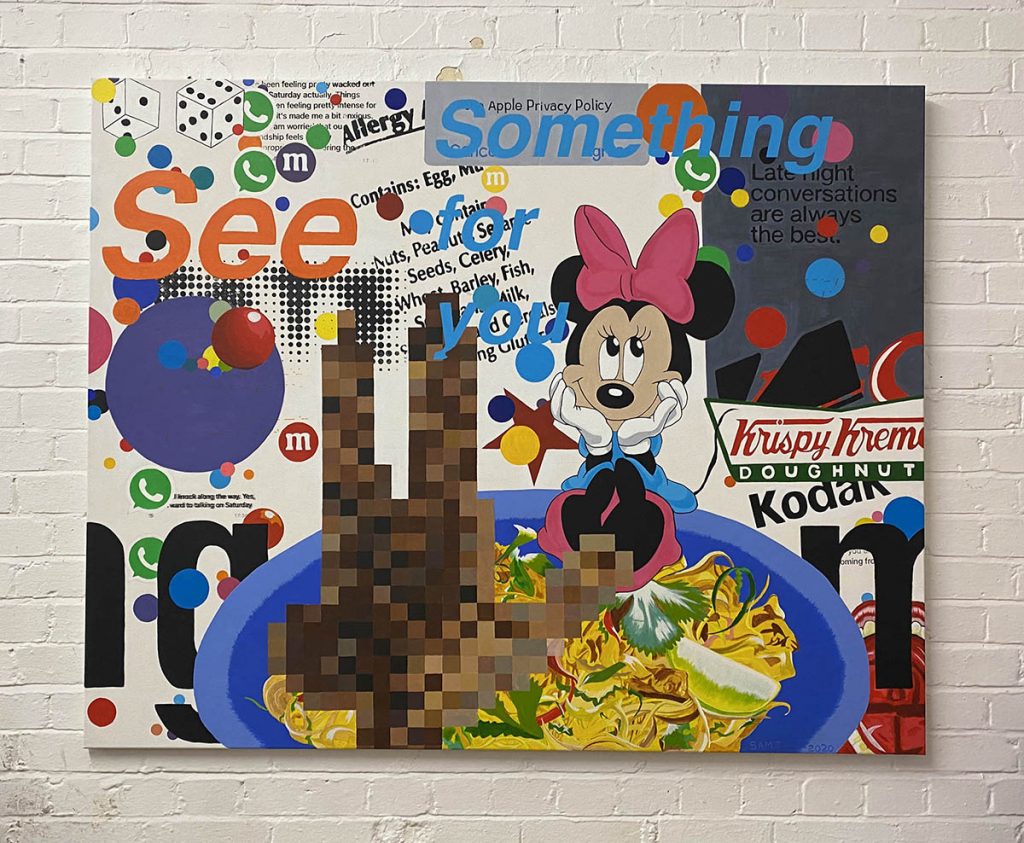Our Featured artist this month is London based Sam Tahmassebi, previously a reciepient of the Road to Rio Award, Tahmassebi’s paintings use images from pop culture to describe how our social selves are represented online. Please keep reading for a short interview.

Hey Thanks for speaking with us, I’m interested in your use of the same characters in multiple paintings, if you see an implied narrative across paintings, or how specific the signifiers are. Wile E Coyote is a figure that it’s pretty easy to project a narrative onto, I was struck by the painting where he’s pixelated out, looking at the plate of thai food.
The use of characters is very specific. Minnie Mouse, made by Disney, is an American company and encoded within that is its significant market and global cultural dominance. She signifies that partially, but also normativity, orthodoxy and hegemony. Wild e Coyote, on the other hand is the product of Looney Tunes and Warner Bros., a company of Polish Jewish migrants who fled to the U.S, in this sense, Wild e, signifies the Other. There’s a narrative or perhaps, a dialogue between the characters on both a micro and macro level throughout all the paintings in the series.

The pixilation I hope his easy to understand – the moment when you become your digital-self IRL – the idea of two identities, the online and the ‘real’. Context is everything, right? Context shapes us, and our experiences, so in this way, it’s crucial to fully experiencing this series of paintings and the ideas within them. I plan for there to be around 20 and hopefully a couple of sculptures and an interactive installation element, too.

As an aside, what you’ve been reading lately?
Reading is a great passion of mine but it does take up time, so I’m quite into audible books. Still unsure if that’s reading to the reading aficionados or intelligentsia. Nevertheless, I’m a huge fan of Blinkist and most recently I’ve listened to On the Origin of Species, Charles Darwin and Capitalism and Freedom, Milton Friedman. My actual reading of late has been Simulacra and Simulation by Jean Baudrillard and Nobody Knows My Name, James Baldwin.
We were always asking before, what shows people had seen that stood out to them, focusing on UK painting, typically. Because most things are shut down, how have you been looking at art? Or did you have any projects delayed by quarantine that you’d like to share, either how they’ve been rescheduled or if they found a new form?
I mostly use Instagram to experience art or mailing lists from galleries. I would still rather stand in front of an artwork, but adaptability is the key to survival. I haven’t had anything delayed, but with everything that’s going on, I’ve felt compelled to make different work in response to it. My practice has always been socially and politically directed, so I should have a video piece or two coming out soon.
Speaking of work presented online, I was wondering about the photographs printed on aluminium, which I saw on your website, images which in many cases I was quite familiar with, the Two kids in Mcdonalds, the Syrian Boy in the Ambulance, but also some images whos provenance was unclear to me, The Vegan Donut for example, or images that look like they are from social media or the New York Times.
I have been debating whether or not to still include those photographs in my practice. They were a failure; sometimes it’s good to keep those as a reminder. They were a response to another book, Camera Lucida, by Roland Barthes. I think he missed the exploitative nature of photography and now with social media we can see that more clearly. Everything’s being exploited and then organised by people of their own volition for consumption through hashtags. The process was just searching the most random hashtags I could think of and seeing what came up if anything. As with my paintings, the majority of imagery is taken from the Internet, and throughout my practice there’s a interest with how the internet is changing our relationship with images, reality, commodities, and more importantly, each other.
The last two questions, Can you think of an older painter whose due for a critical renaissance?
I think Michel Majerus, made exceptional work that really drew attention to the complex relationship between media and landscapes. I hope he gets a revival.
And also if you have a guilty pleasure you’d share with us?
Guilty pleasures? I try not to feel guilty ever – it’s kind of a redundant emotion. I like giving and seeing the look of surprise and joy on other people’s faces. They think it’s about them, but it’s all about me.
Interview by Ben Duax, June 2020

